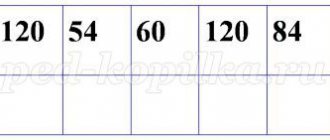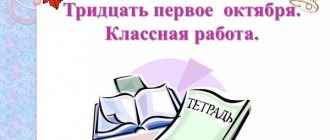Lesson summary: “Generalized repetition of phonetics, graphics, spelling, spelling” (grade 10)
№ 14. Topic: Generalized repetition
phonetics, graphics, spelling, orthography.
10th grade Russian language 10/18/2017
Target:
generalize knowledge on the topic: “Phonetics, graphics, spelling, spelling”; work on the formation of spelling actions related to the spelling of vowels and consonants at the root of the word; strengthen your pronunciation skills.
Lesson objectives:
Educational:
create conditions for determining the assimilation of program material when studying sections of the science of language: “Phonetics, graphics, spelling, spelling.”
Developmental:
create conditions for the development of skills and abilities of students acquired in the study of sections of the science of language: “Phonetics, graphics, spelling, spelling” and logical thinking.
Educational:
create conditions for nurturing a culture of speech behavior, collective responsibility, mutual assistance, shaping the personality of students through hard work, attention in class, interest in Russian language lessons, and nurturing a love for the Russian language.
Lesson type
:
A lesson in mastering skills and abilities.
During the classes.
- Org moment.
- Updating students' background knowledge and practical experience.
Working with transcription. The handout contains a written utterance in phonetic transcription. Restore this statement in accordance with spelling and punctuation rules.
[Y'esl'i vynach'n'ot'e sud'it' l'ud'ey'/ uvas n'ikhvat'it vr'em'in'i nato shtoby l'ub'it' them]
If you start judging people, you won't have enough time to love them. Mother Teresa.
Orthoepic minute.
Put emphasis
Pamper, contract, enviable, catalog, prettier, bonus, pine needles, Ukrainian, owners, sorrel, busy, beets, cakes, bows, rings, seal, apostrophe, in-depth, expert.
Pamper, agreement, enviable, catalogue, more beautiful, bonus, pine needles, Ukrainian, owners, sorrel, busy, beets, cakes, bows, ringing, sealing, apostrophe, in-depth, expert.
Conversation:
- So, guys, let's remember what phonetics is?
— Graphics are (
branch of the science of
language
, which studies the shapes of the letters of the alphabet and their relationship to the sounds of speech)
— Orthoepy is (studies the Norms of literary pronunciation)
— Spelling is
- Communicating the topic, purpose, objectives of the lesson and motivating the educational activities of schoolchildren.
Based on the work done, please formulate the topic of our lesson. Right! “ Generalized repetition of phonetics, graphics, spelling, spelling”
- Primary application of acquired knowledge
Training exercise.
Restore the text in accordance with spelling and punctuation standards.
[kakda ch'ilav'eka bran'at / this abych'na aznach'ait / that he abladait y'asna expressed character]
When a person is scolded, it usually means that he has a clear character. T. Edwards
[ch'ilav'ek b'es pr'intsypaf ib'is vol'i plow na karable'/ u ka-torav 'n'et rul'a and komps: he m'in'a]'it sfa]'o directed'en'ire with every p'ir'i m'eny in'etra //]
A man without principles and without will is like a ship that has no rudder or compass: it changes its direction with every change of wind. S. Smiles
PHYSICAL MINUTE
- Students apply knowledge under standard conditions to master skills.
Task No. 1.
Indicate the erroneous judgment.
- In the word EAT, the number of letters and sounds coincides.
- In the word MOUSE, the letter b indicates the softness of the preceding consonant.
- In the word SUN, the consonant sound [l] is unpronounceable.
- In the word HORSEMAN the first sound is [f].
Task No. 2.
Indicate the erroneous judgment.
- In the word SINGS, all consonant sounds are unvoiced.
- The word FLYING has the sound [v].
- The word WHITE contains more sounds than letters.
- The first sound in a word is ALWAYS [f].
Task No. 3.
Indicate the erroneous judgment.
- The word SHARP has the sound [s].
- The word VYUGA has more letters than sounds.
- There is no [s'] sound in the word AFRAID.
- The spelling of the word CLAMP does not match the pronunciation.
Task No. 4.
Indicate the erroneous judgment.
- The word SEW has four sounds.
- The word TUESDAY has the sound [f].
- In the word YOUTH the last consonant is hard.
- In the word BELIEVE, all consonants are soft.
Task No. 5.
Indicate the erroneous judgment.
- There is no [t] sound in the word UNDERGROUND.
- The word FURIOUS has more letters than sounds.
- The word SLIP contains the sound [f].
- All the consonants in the word ZhMUTZYA are hard.
Task No. 6.
Indicate the erroneous judgment.
- In the word CUT, all sounds are soft.
- In the word CREATE, the number of letters and sounds coincides.
- The word EAT has six sounds.
- The word STAR has an unpronounceable consonant sound.
Task No. 7
.Indicate the erroneous judgment.
- In the word THROW, the softness of the consonant [s'] is indicated in writing by the letter b (soft sign).
- In the word ARRIVE, the letter b does not indicate in writing the softness of the preceding consonant.
- The word DRINKER has more letters than sounds.
- The word MURGE contains the sound [w].
Task No. 8.
Indicate the erroneous judgment.
- The word PASSIONATE has more sounds than letters.
- In the word CLOCK, all consonant sounds are soft.
- The word SURRENDER contains the sound [z].
- The word ALIEN has the sound [v].
Task No. 9.
Indicate the erroneous judgment.
- There is no [t] sound in the word LOCAL.
- The word has an AMAZING number of letters and sounds that coincide.
- The word BLOOD has the sound [f].
- The word BOOK consists of seven sounds.
Task No. 10.
Indicate the erroneous judgment.
- In the word MADE, all consonants are voiced.
- In the word ALIVE, all consonants are hard.
- The first sound in the word ENTER is [f].
- In the word SINGING, the number of letters and sounds coincides.
Practical exercise.
Rewrite by inserting the missing letters.
1)
Everything that a person is able to imagine in his imagination, others dare to put into practice. (J. Bern.) 2) The reason..the patch and the plaster..can be glued anywhere. (Japanese proverb.) 3) The mind takes one barrier after another, stupidity does not know the right direction at all. (V. Lebedev.) 4) To exist means to be..conceivable. (J. Berkeley.) 5) The world is structured in such a way that people glorify dead saints and follow the living. (Howie.) 6) Many misconceptions are caused by the need to pr..decorate: not in order to understand, but to excite the imagination. (Saint Exepury) 7) Maturity is not so much age as overcoming difficult roads. (V. Borisov.)
6. Lesson summary (reflection)
-So, guys, our lesson was dedicated to...
— At the beginning of the lesson, we set goals...
- Have we reached them?
- Let's remember what phonetics is?
— Graphics are (
branch of the science of
language
, which studies the shapes of the letters of the alphabet and their relationship to the sounds of speech)
— Orthoepy is (studies the Norms of literary pronunciation)
— Spelling is
7. Homework message.
pp. 218-220 (know rubbish), exercise 304(1,2)
4



